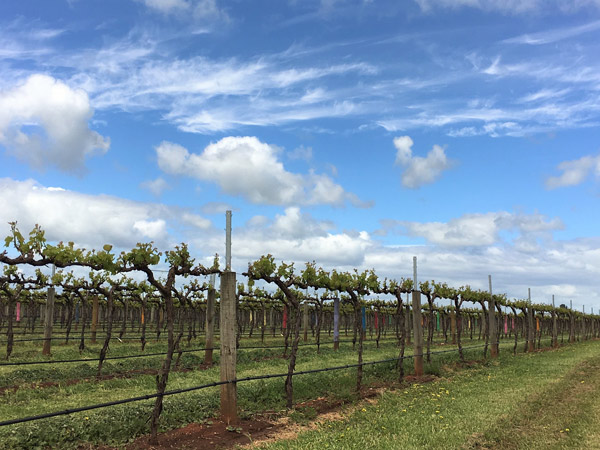A long-term project is underway in Coonawarra to broaden our understanding of rootstock performance in that region. This month a ‘walk through the vineyard’ will be held on 22 March for growers and winemakers in the Limestone Coast to discuss results of the trial to date and to taste grapes from the different rootstock/scion combinations pre-vintage.
Rootstock use in South Australia is currently limited to approximately 26% of plantings (only 11% in Coonawarra), thus facilitating high susceptibility to phylloxera. A long term, randomised and replicated rootstock trial was setup in 2009 as a partnership between Vinehealth Australia, Treasury Wine Estates and Coonawarra Vignerons, on the region’s famed terra rossa soil, to compare the performance of own-rooted Cabernet Sauvignon (CW 44 clone) vines against that of eight rootstocks of varying vigour.
This trial is evaluating the following rootstocks, including three bred by CSIRO* as low-moderate vigour rootstocks with reduced potassium uptake:
| 110 Richter | Ramsey | 1103 Paulsen | 140 Ruggeri |
| Börner | M6262* | M5489* | M5512* |
This trial also evaluates Börner, a German-bred rootstock only currently planted to 0.15Ha in SA, touted as immune to phylloxera, but has been found to support some root-feeding in Australia.
Measurements
A number of measurements have been consistently collected over the past few seasons including:
- Maturity (Baume, pH, Titratable Acidity);
- Yield (weight per vine, bunch number, bunch weight);
- Pruning measurements (trunk circumference, bud number, cane number, cane weight); and
- Colour analysis and salt analysis to be undertaken for vintage 2017.
All rootstocks have been pruned back to a standard bud number each season and as a result we can confidently say that rootstock has played a significant role in affecting the vast majority of yield and vigour components over the past two seasons and this was not driven by differences in bud number for the different rootstocks.
Some results from past two seasons
- Rootstocks affected yield and growth habit.
- Apparent bunch weight differences were likely driven by differences in berry number per bunch and berry weight (to be investigated in 2016/17).
- General consistency in results for yield and canopy measures with Own roots, Börner and M6262 generally lowest for measured attributes and 110 Richter, 1103 Paulsen and 140 Ruggeri generally highest for measured attributes.
- As expected, rootstocks with high fruitfulness also had higher yield, larger bunches, higher pruning weight and larger trunk circumferences.
- Some interesting maturity results were noted with M5489 showing the fastest rate of ripening and lowest pH at harvest; whereas Own roots and M6262 showed lowest titratable acidity and Own roots had highest pH at harvest.
- Own roots appears slower growing than all rootstocks.
- Merbein clones planted as potted vines one year after other rootstocks, and especially M6262, are slow to establish.
- Börner rootstock, rated overseas as conveying high vigour to the scion, appears in this trial to be moderated by the calcareous soil or for another reason.
Season 2016/17
Now in its seventh year, this trial is continuing to improve our understanding of the attributes rootstocks can convey to scions and the environments and purposes for which they are therefore best suited.
“We are gearing up for maturity sampling to begin and for collection of yield parameters closer to harvest. This season will be the first during which we undertake ‘small lot’ winemaking to assess quality and style,” says Suzanne McLoughlin, Vinehealth Australia Technical Manager.
Results from this vintage will be shared in later editions of this e-newsletter and in feature articles in industry journals.
Importance of Rootstocks
Grape phylloxera (Daktulsphaira vitifoliae) is a devastating pest of grapevines worldwide, affecting both commercial and ornamental vines. Adult phylloxera feed on leaves and/or grapevine roots causing death of the European grapevine, Vitis vinifera (that we term ‘own-rooted’ vines).
In Australia, the roots of V. vinifera, are extremely susceptible to attack by the phylloxera present, but the leaves are resistant to these strains. Rootstocks used commercially in Australia are considered to vary in their resistance, or tolerance, to different phylloxera strains, and research continues in this area.
Phylloxera tolerant rootstocks are those on which phylloxera can feed, reproduce and cause root galling (nodosities), but limited economic damage. Phylloxera resistant grapevines are those on which phylloxera cannot develop to the adult stage so there is no egg production and no gall production.
With the lack of available chemical or biological controls for phylloxera, the only proven cultural method to manage phylloxera is to pull out infested own-rooted vines and replant with new vines that have been grafted onto phylloxera-resistant American rootstocks.
Grafted propagation material is traditionally used to manipulate vine performance. Drivers for rootstock use are wide ranging and include:
- Phylloxera
- Nematodes
- Salt tolerance
- Water-use efficiency and drought tolerance
- Reduced vigour to counter the negative impacts of high vigour on berry composition
- Reduced potassium uptake to counter the impact of high berry potassium on pH
The fact that 74% of South Australian vineyards are on own roots underlines the susceptibility of South Australian vineyards to phylloxera. Vinehealth Australia is a keen supporter of research to better understand rootstock characteristics and their impact on vine attributes and wine quality and style.
For more information about the Rootstock Trial vineyard walk visit https://limestonecoastwine.com.au/whats-on/field-day-coonawarra/.
